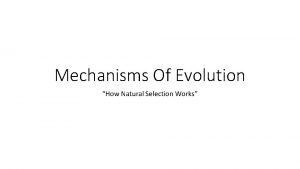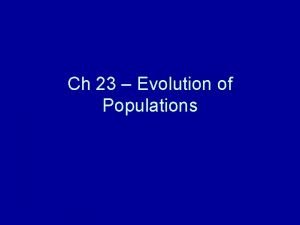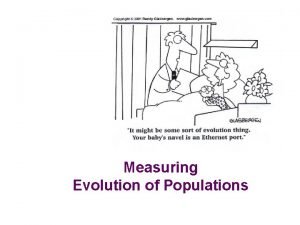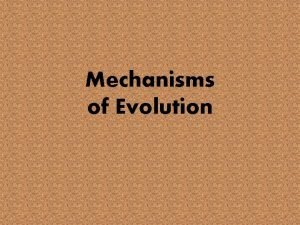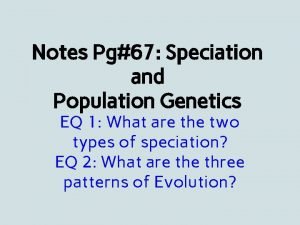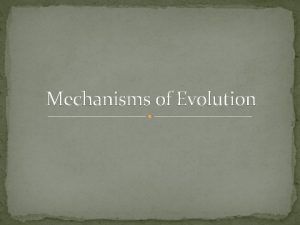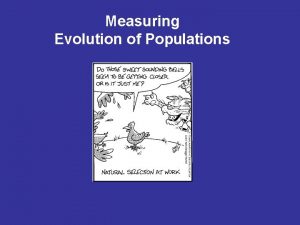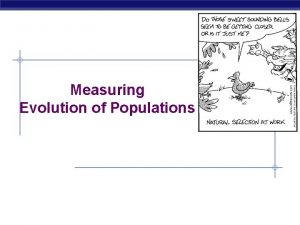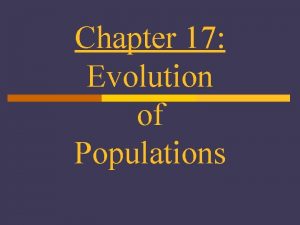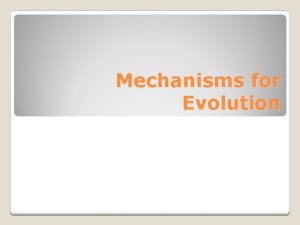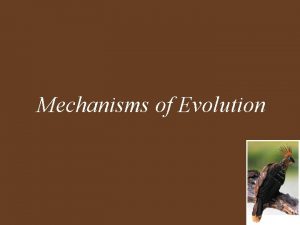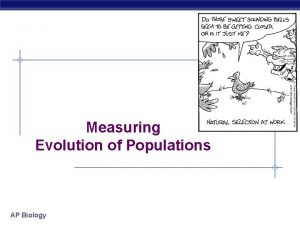Measuring Evolution of Populations 5 mechanisms of evolutionary





















- Slides: 21

Measuring Evolution of Populations

5 mechanisms of evolutionary change Mutation Gene Flow Genetic Drift AP Biology Non-random mating Selection

Populations & gene pools § Concepts a population is a localized group of interbreeding individuals u gene pool is collection of alleles in the population u § remember difference between alleles & genes! u allele frequency is how common is that allele in the population § how many A vs. a in whole population AP Biology

Evolution of populations § Evolution = change in allele frequencies in a population. u u hypothetical: what conditions would cause allele frequencies to not change? non-evolving population REMOVE all agents of evolutionary change 1. very large population size (no genetic drift) 2. no migration (no gene flow in or out) 3. no mutation (no genetic change) 4. random mating (no sexual selection) 5. no natural selection (everyone is equally fit) AP Biology

Hardy-Weinberg equilibrium § Hypothetical, non-evolving population u preserves allele frequencies § Serves as a model u u natural populations rarely in H-W equilibrium useful model to measure if forces are acting on a population § measuring evolutionary change G. H. Hardy APmathematician Biology W. Weinberg physician

Hardy-Weinberg theorem § Counting Alleles assume 2 alleles = B, b u frequency of dominant allele (B) = p u frequency of recessive allele (b) = q u § frequencies must add to 1 (100%), so: p+q=1 BB AP Biology Bb bb

Hardy-Weinberg theorem § Counting Individuals u u u frequency of homozygous dominant: p x p = p 2 frequency of homozygous recessive: q x q = q 2 frequency of heterozygotes: (p x q) + (q x p) = 2 pq § frequencies of all individuals must add to 1 (100%), so: p 2 + 2 pq + q 2 = 1 BB AP Biology Bb bb

H-W formulas § Alleles: p+q=1 B b BB Bb b Bb § Individuals: p 2 + 2 pq + q 2 =1 BB AP Biology BB Bb Bb bb bb bb

Using Hardy-Weinberg equation population: 100 cats 84 black, 16 white How many of each genotype? p 2=. 36 BB q 2 (bb): 16/100 =. 16 q (b): √. 16 = 0. 4 p (B): 1 - 0. 4 = 0. 6 2 pq=. 48 Bb q 2=. 16 bb are population the genotype frequencies? Must. What assume is in H-W equilibrium! AP Biology

Using Hardy-Weinberg equation p 2=. 36 Assuming H-W equilibrium 2 pq=. 48 q 2=. 16 BB Bb bb p 2=. 20 =. 74 BB 2 pq=. 64 2 pq=. 10 Bb q 2=. 16 bb Null hypothesis Sampled data How do you explain the data? AP Biology

HARDY-WEINBERG PRACTICE PROBLEMS p+q=1 p 2 + 2 pq + q 2 = 1

Black (b) is recessive to white (B) Bb and BB pigs “look alike” so can’t tell their alleles by observing their phenotype. ALWAYS START WITH RECESSIVE alleles. p= dominant allele q = recessive allele 4/16 are black. So bb or q 2 = 4/16 or 0. 25 q= 0. 25 = 0. 5

http: //www. phschool. com/science/biology_place/labbench/lab 8/samprob 1. html Once you know q you can figure out p. . . p+q=1 p + 0. 5 = 1 p = 0. 5 Now you know the allele frequencies. The frequency of the recessive (b) allele q = 0. 5 The frequency of the dominant (B) allele p = 0. 5

WHAT ARE THE GENOTYPIC FREQUENCIES? You know pp from problem bb or q 2 = 4/16 = 0. 25 BB or p 2 = (0. 5)2 = 0. 25 Bb = 2 pq = 2 (0. 5) = 0. 5 25% of population are bb 25% of population are BB 50% of population are Bb http: //www. phschool. com/science/biology_place/labbench/lab 8/samprob 1. html

PRACTICE HARDY WEINBERG 1 in 1700 US Caucasian newborns have cystic fibrosis. C for normal is dominant over c for cystic fibrosis. Calculate the allele frequencies for C and c in the population Image from: BIOLOGY by Miller and Levine; Prentice Hall Publishing © 2006

1/1700 have cystic fibrosis q 2 = 1/1700 q= 0. 00059 q = 0. 024 p = 1 – 0. 024 = 0. 976 Frequency of C = 97. 6% Frequency of c = 2. 4% NOW FIND THE GENOTYPIC FREQUENCIES

CC or p 2 = (0. 976)2 = . 953 Cc or 2 pq = 2 (0. 976) (0. 024) = 0. 0468 cc = 1/1700 = 0. 00059 CC = 95. 3% of population Cc = 4. 68% of population cc =. 06% of population

Within a population of butterflies, the color brown (B) is dominant over the color white (b). And, 40% of all butterflies are white. q 2 = 0. 4 q= 0. 4 = 0. 6324 p = 1 - 0. 6324 = 0. 3676 aa = 0. 4 = 40% Aa = 2 (0. 632) (0. 368) = 0. 465 =46. 5% AA = (0. 3676) =. 135 = 13. 5% Image from: BIOLOGY by Miller and Levine; Prentice Hall Publishing © 2006

Now you can answer questions about the population: How many people in this population are heterozygous? 0. 0468 (1700) = 79. 5 ~ 80 people are Cc It has been found that a carrier is better able to survive diseases with severe diarrhea. What would happen to the frequency of the "c" if there was a epidemic of cholera or other type of diarrhea producing disease? Cc more likely to survive than CC. c will increase in population

The gene for albinism is known to be a recessive allele. In Michigan, 9 people in a sample of 10, 000 were found to have albino phenotypes. The other 9, 991 had skin pigmentation normal for their ethnic group. Assuming hardy-Weinberg equilibrium, what is the allele frequency for the dominant pigmentation allele in this population? q 2 = 9/10000 q= 0. 0009 q = 0. 03 p = 1 – 0. 03= 0. 97 Frequency of C = 97% Frequency of c = 3%

CC or q 2 = (0. 976)2 = . 953 Cc or 2 pq = 2 (0. 976) (0. 024) = 0. 0468 cc = 1/1700 = 0. 00059 CC = 95. 3% of population Cc = 4. 68% of population cc =. 06% of population
 Natural selection vs evolution
Natural selection vs evolution Section 19-2 review measuring populations
Section 19-2 review measuring populations Evolution of populations section 16-1 genes and variation
Evolution of populations section 16-1 genes and variation Why are populations the smallest unit of evolution
Why are populations the smallest unit of evolution Chapter 16 evolution of populations vocabulary review
Chapter 16 evolution of populations vocabulary review Section 16-1 genes and variation
Section 16-1 genes and variation Chapter 17 evolution of populations answer key
Chapter 17 evolution of populations answer key Evolution of populations section 11 review
Evolution of populations section 11 review Chapter 23: the evolution of populations
Chapter 23: the evolution of populations Chapter 23 the evolution of populations
Chapter 23 the evolution of populations Stabilizing selection human birth weight
Stabilizing selection human birth weight Chapter 15 section 3: shaping evolutionary theory
Chapter 15 section 3: shaping evolutionary theory Hemoglobin c
Hemoglobin c Mechanisms of evolution
Mechanisms of evolution Mechanisms of evolution
Mechanisms of evolution Mechanisms of evolution
Mechanisms of evolution Mechanisms of evolution
Mechanisms of evolution Mechanisms of evolution graphic organizer
Mechanisms of evolution graphic organizer 5-1 how populations grow
5-1 how populations grow Speciation
Speciation Complex patient populations
Complex patient populations Whats a density dependent limiting factor
Whats a density dependent limiting factor
